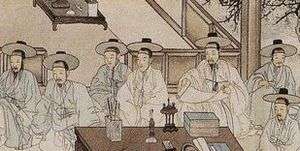Korean knots
 |
| Part of a series on the |
| Culture of Korea |
|---|
| History |
|
Music and performing arts |
|
|
Monuments |
|
National symbols of Korea |
|
Korean knots is a traditional Korean handicraft. The finished knot has the same shape at the front and at the back, has bilateral symmetry, and can be made using one or two threads. While the practice is comparable to Chinese knots, Korean knots differ in their braiding technique and are tied without the use of tools. They also differ from Chinese knots in their historic development.
Traditionally, the knots were used primarily as hunting tools and their usage was initially limited to royal families, spreading later to common people. Today, modern Korean artists are using the traditional knots in their works.
History of Korean Knots
Prehistory
In prehistoric times, Korean knots were used solely for practical purposes.They were tied around the waist and used to carry stone-axes, swords, and other tools used for hunting and food. Tools from the Stone Age exhibit holes where thread was looped through and then knotted. Similar evidence is found in relics of the Bronze Age. The knots were strengthened by twisting or weaving multiple strings.
Three Kingdoms of Korea (4th century - 668 CE)
During the period of the Three Kingdoms of Korea, people began to see aesthetic value in knots and started to use them as decorations on clothes, swords, and more. The Samguk Sagi, the oldest extant record of Korean history, describes knot usage in everyday life during the Silla dynasty, noting rulers enjoyed using knots to adorn horses.
Period of the Goryeo dynasty (918-1392)
Descriptions of various knot forms made in the Goryeo dynasty are in poetry and Buddhist art. During this period, knots were widely used as ornaments in accessories and for art. No knots from the Goryeo period survive today.
Period of Joseon dynasty (1392-1910)
During the Joseon dynasty, knots became more diverse and elaborate. They were used to decorate traditional instruments and clothes, especially women’s garments and jewelry. The Joseon rulers hired their own knot-makers to decorate the palace and jewelry for the noble family.
Korea under Japanese Rule (1910-1945)
Demand for knots were so high among Koreans that knots became commercialized. But demand decreased after the Japanese enacted policies designed to obliterate Korean culture and a surge of Western culture into the Korean peninsula shifted traditions. They became rarely seen in public.
Types of Korean knots
There are more than 30 basic types of knots, but there are vast numbers of variations and regional version on these basic types. Some of the most common knots include:
- Dorae knot - the most basic form of knot, it is used to connect knots and to fix or finish a knot.
- Maehwa knot - this knot resembles a Japanese apricot flower and is used for baby clothes and Norigae, Korean traditional ornaments worn by women.
- Dalki knot - this knot resembles a strawberry.
- Guidorae knot - there are many different names that describe this type of knot, but is normally called the Guidorae. This knot tends not to be fixed.
Usage of Korean knots
Knots of diverse colors were used as belts, identity tags, and as a decorative element on instruments. In the ruling palaces, knots were used to signify dignity and prestige. For religious purposes knots decorated Buddhist ornaments.
The most common use of knots was in Norigae, traditional Korean ornaments worn by women to decorate clothing. Norigae were used by all ages and social statuses to emphasize the beauty of Korean traditional costume, as well as decorate pockets carried separately. Though these knots were used across all social statuses, there were also cases when only specific people were allowed to use them. For example, only high government officials were allowed to use knots for decorating fans.
Korean Knots in modern Korea
After the establishment of a cultural industry bureau in South Korea in 1994, the use of knots modern life increased, especially in cultural products. Korean knots were also used in the designs of non-Korean artists, usually in forms of the Garackji knot (a basic knot used to fill space and give a classical touch) and the Mangsa knot (used on pouches for jewelry).
References
1) Lee Jong Kyu, “Study of Fashion design using Korean Traditional Knots” (한국전통매듭을 응용한 패션 디자인 연구), Master’s Thesis. Sookmyung Women’s College. (2009)
2) Lim Young Ju, "Study of Korean Traditional Knots"(한국 전통 매듭에 관한 연구), Doctor's Thesis. Won Kwang University. (2002)
3) Kim Johnson Young, "Study of accessory design using Korean Traditional knots (한국전통매듭을 응용한 장신구 디자인 연구), Master's Thesis. SungKyunkwan University. (2005)